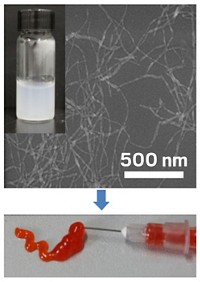Advertisement
Grab your lab coat. Let's get started
Welcome!
Welcome!
Create an account below to get 6 C&EN articles per month, receive newsletters and more - all free.
It seems this is your first time logging in online. Please enter the following information to continue.
As an ACS member you automatically get access to this site. All we need is few more details to create your reading experience.
Not you? Sign in with a different account.
Not you? Sign in with a different account.
ERROR 1
ERROR 1
ERROR 2
ERROR 2
ERROR 2
ERROR 2
ERROR 2
Password and Confirm password must match.
If you have an ACS member number, please enter it here so we can link this account to your membership. (optional)
ERROR 2
ACS values your privacy. By submitting your information, you are gaining access to C&EN and subscribing to our weekly newsletter. We use the information you provide to make your reading experience better, and we will never sell your data to third party members.
Pharmaceuticals
A Stem Cell Special Delivery
ACS Meeting News: Neural stem cells show promise for delivering chemotherapy directly to brain tumors
by Lauren K. Wolf
September 10, 2013
For people with aggressive brain tumors called glioblastomas, the prognosis isn’t good: Even after surgery and chemotherapy, patients, on average, survive for 15 months.
But researchers are trying to improve that statistic by using neural stem cells (NSCs) to deliver targeted doses of the cancer drug doxorubicin to glioblastomas. The work was presented yesterday at the American Chemical Society national meeting in Indianapolis by postdoctoral researcher Yu Cheng, a member of a team led by Maciej S. Lesniak at the University of Chicago’s Brain Tumor Center.
Neural stem cells are immature cells that can eventually become full-fledged nerve cells in the brain. According to Cheng, NSCs have built-in homing mechanisms that allow them to “sniff out” tumors and migrate toward malignant masses. Lesniak, Cheng, and colleagues took advantage of this capability, turning the cells into a type of Trojan horse for chemotherapy.
They filled porous silica nanoparticles with doxorubicin and manipulated NSCs to take up the tiny materials inside their cell walls. Then the researchers injected the cells into the brains of mice just a few millimeters from grafted glioblastomas. Over the course of a few days, the NSCs migrated to the tumors, where, because of toxic effects of doxorubicin on the stem cells themselves, they burst and released the chemotherapy agent onto the malignant growths. One injection of cells extended the lives of experimental mice by seven to eight days (Small 2013, DOI: 10.1002/smll.201301111).
“To the best of our knowledge, we are the first to deliver drug-loaded nanoparticles with NSCs,” Cheng said. The Food & Drug Administration has approved these neural stem cells for use in human clinical trials, which could facilitate moving the NSC-nanoparticle agents into tests on human brain cancer patients.
Georgia Tech nanomedicine expert Younan Xia, says that, although the study is interesting, he worries that because the researchers locally injected NSCs into the brains of mice, the approach might not be as practical as a medicine that could be injected into a person’s arm.
But the line of NSCs the team used has been approved only for local injection, Cheng tells C&EN. She agrees that systemic administration should be a goal for the future, but right now the team wants to get the treatment into clinical trials quickly, and the best way to do that is to administer the NSCs as indicated.






Join the conversation
Contact the reporter
Submit a Letter to the Editor for publication
Engage with us on Twitter